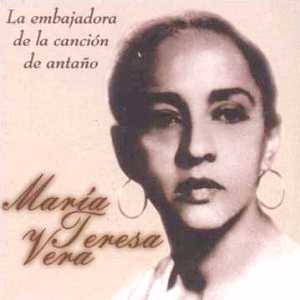9.8.4 María Teresa Vera

María Teresa Vera, Cuban guitarist, singer, and composer, was born on February 6, 1895, in Guanajay, Havana. She was the daughter of a Spanish soldier and a descendant of Cuban slaves. She grew up in a Havana family, where her mother worked as a servant. She studied guitar with teachers José Díaz and Manuel Corona.
She made her debut in March 1911 at the Politeama Grande Theater, located in Manzana de Gómez, performing his composition Mercedes, accompanied by troubadour Manuel Corona. She performed with him on several occasions, performing his works, along with the latter’s guitar and choir.
Together with Rafael Zequeira, he formed a duo that launched his artistic career, a duo that he maintained from 1916 to 1924. They performed at the Apollo Theater in New York in 1918. They dedicated themselves to cultivating Cuban song. They recorded more than 100 songs, many of which became major popular hits.
In 1922, she traveled to New York again, but this time with Corona, and was signed to RCA Victor. Vera also joined other duos, such as the one with Miguel García, as well as quartets with Justa García, Dominica Verges, and Lorenzo Hierrezuelo; and another with Hierrezuelo, Hortensia López, and Isaac Oviedo.
He founded the Sexteto Occidente in 1926. It was composed of Miguel García (backing vocals), Manolo Reynoso (bongo), Julio Viart (tres), Ignacio Piñeiro (double bass), and Francisco Sánchez (chorus and maracas). This group lasted only a few years, and its recordings were rare.
Beginning in 1935, she was accompanied by Lorenzo Hierrezuelo, forming a duo that remained in the Cuban music scene for over twenty-five years. In 1945, they were hired by the CMQ Circuit to perform on the program Cosas de ayer (Things of Yesterday). This became a very popular duo, despite breaking with the norm, as this type of format was predominantly composed of men. In it, Vera established herself as one of the leading voices of Cuban trova.
In 1947, they toured Mexico, performing at the Los Tulipanes and Motembo cabarets in Mérida, Yucatán. In 1959, they were hired by the CMZ radio station, part of the Ministry of Education. Their last public appearances were at the Fourth Festival of Folkloric, Popular, and Vernacular Music, and at the First and Second Festivals of Cuban Traditional Music, held in 196.
María Teresa was a singer who captured the attention of the American recording industry, where she recorded for the Victor, Columbia, Brunswick, and other labels. She was accompanied by those who performed with her in two-part combinations and alongside those who performed part of the instrumental accompaniment. Her unique and diverse artistry was recorded.
Vera sang in parks, hospitals, tobacco shops, lodges, societies and guilds, on theater stages, and in neighborhood movie theaters, especially at the Esmeralda, an emblematic trova venue, a small and charming venue located near the Cuatro Caminos Market. Her repertoire included a wide variety of musical genres, including boleros, songs, criollas, bambucos, guarachas, sones, rumbas, and habaneras.
The habanera “Veinte años” (Veinte años) is the classic piece of this troubadour’s work. It has been covered and performed by numerous singers from around the world.
Among the works composed by María Teresa we can find:
Bambuco: This Time It Was Time to Lose, text: Emma Núñez Valdivia (1914); Face to Face, text: González Ramos (1939).
Bolero: Virgen del Cobre (1922); You Can’t Understand, text: Guillermina Aramburo (1930); Your Voice and I Want You to Know, texts: Emma Núñez Valdivia (1930); Finally and You Will Remember Me (1930); I Can’t Love You Now, text: Guillermina Aramburo (1934); You Don’t Know How to Love Me, Because I Feel Sad and I Want You to Love Me, texts: Guillermina Aramburo (1935); My Revenge, My Anguish and The Last Is the Best, texts: Emma Núñez Valdivia (1941); Always With My Mother and My Sentence, texts: Emma Núñez Valdivia (1942); I Already Met You (1943); Suffer and Wait, I Say Goodbye and I Don’t Love You Anymore (1957).
Bolero-son: Tell Me You Love Me (1937); I Only Think of You (1942). Guaracha: San Juan (1930). Habanera: Twenty Years, lyrics G. Aramburu (1935).
In 1995, a tribute album titled “A María Teresa Vera” was released. It featured prominent artists such as Omara Portuondo, Martirio, Pablo Guerrero, Jacqueline Castellanos, and others.
María Teresa Vera, died on December 17, 1965, in Havana.








